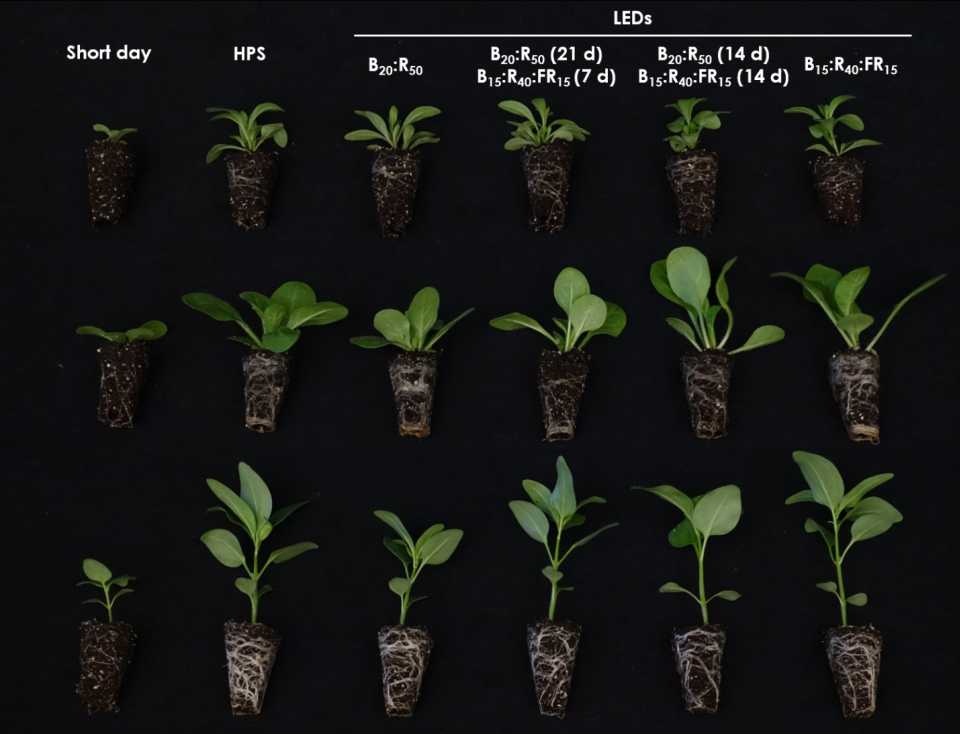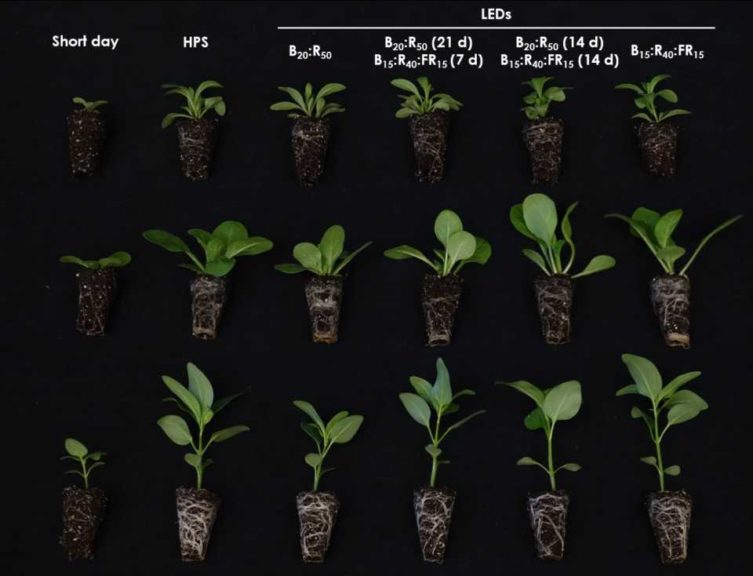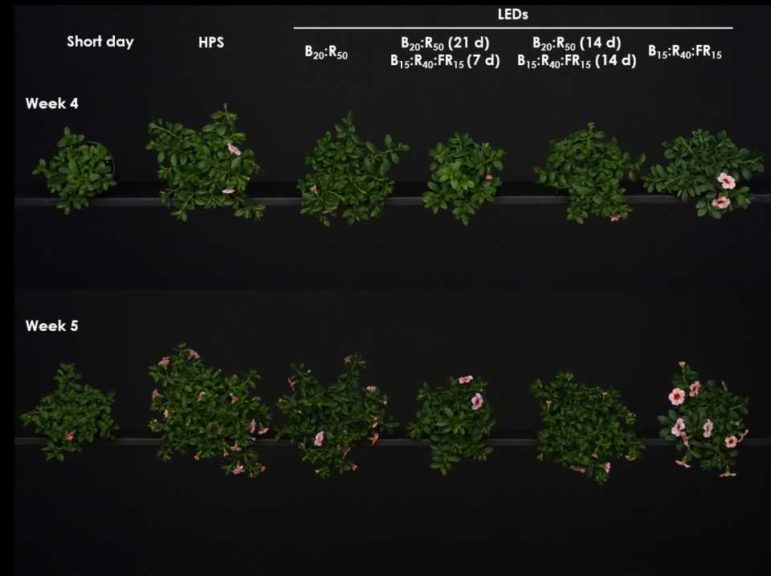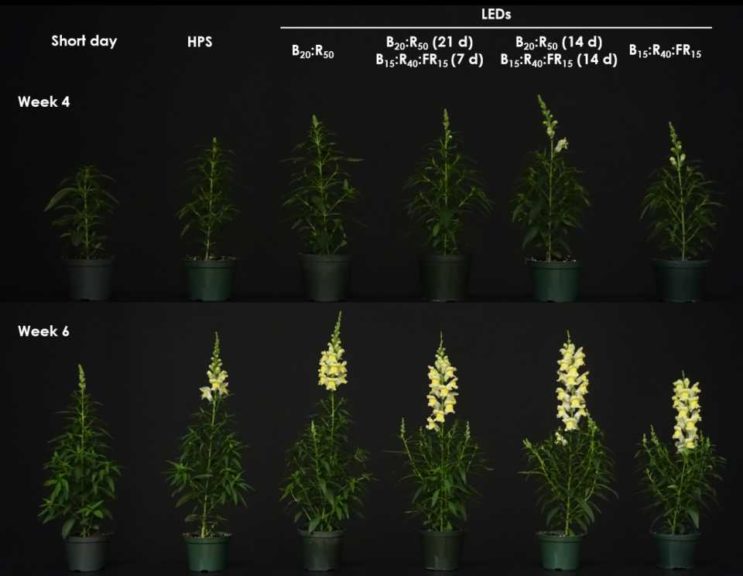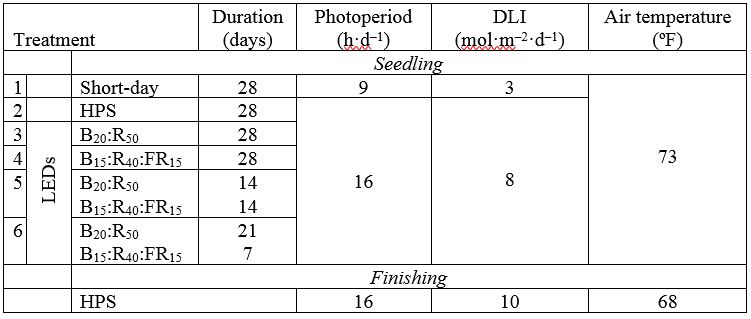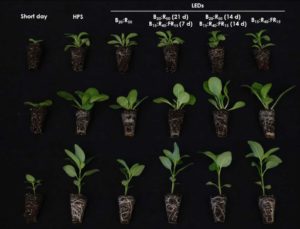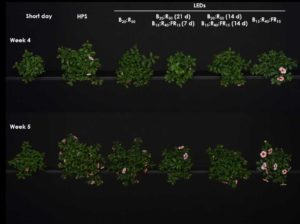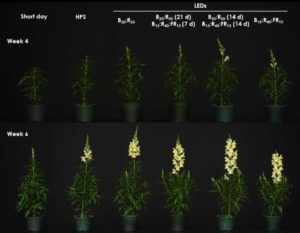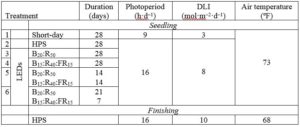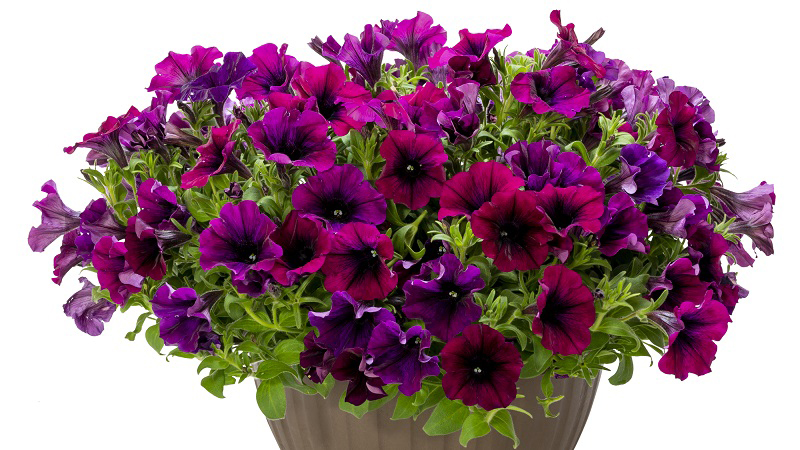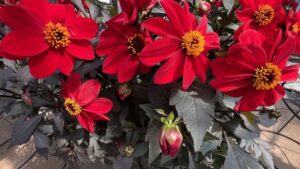How Adding Far-red Radiation Affects Supplemental Lighting of Plant Plugs
It is now common practice for greenhouse growers to use supplemental lighting from high-pressure sodium (HPS) lamps during plug production to provide a daily light integral (DLI) of 8 to 12 mol·m–2·d–1. However, growers are interested in switching to light-emitting diode (LED) supplemental lighting fixtures due to the energy savings, efficacy, long life span, potential rebates, and ability to provide specific light qualities. It is estimated that only 4% to 6% of greenhouses in the U.S. have installed LED supplemental lighting fixtures. Most report fixture costs, uncertainty of which radiation qualities (wavelength) to select, and how crop timing and plant quality will be influenced as reasons for not yet installing LED fixtures.
The majority of fixed spectrum LED supplemental lighting fixtures on the market provide either a mixture of blue (B) and red (R) radiation with or without green (G) radiation (white LEDs). This can potentially affect subsequent flowering of long-day plants grown as either young or finished plants. Flowering of long-day plants is accelerated when supplemental and photoperiodic lighting provide a long day that includes a low R to far-red (FR) radiation ratio. HPS lamps provide a mixture of B, G, R, and FR radiation, which allows growers to force long-day annuals and perennials into flower for spring market dates. Therefore, growers are concerned about investing in LEDs that may or may not contain FR radiation.
Previous research has been conducted to determine how growth and subsequent flowering of young plants is influenced when grown under HPS lamps or fixed spectrum LED fixtures with or without FR radiation. However, the length of time and intensity of FR radiation (µmol·m–2·s–1) in supplemental lighting required to promote flowering of long-day requiring annuals at the seedling stage is largely unknown. Thus, our objective was 1) to determine if LED supplemental lighting providing 70 µmol·m–2·s–1 of B and R radiation, with or without FR radiation for different durations would reduce time to flower of long-day annuals and not result in excessive stretch compared to traditional HPS lamps, and 2) to determine the minimum duration of FR radiation exposure to induce subsequent flowering.
The Experiment
Plant material. Seeds of facultative long-day Calibrachoa ‘Kabloom Light Pink Blast’ and Petunia ‘Wave Carmine Velour’, obligate long-day Snapdragon ‘Liberty Classic Yellow’ and day-neutral Impatiens ‘Accent Premium Red’ were sown in 160-cell trays at Raker-Roberta’s Young Plants (Litchfield, MI). One week later, trays were moved to glass-glazed greenhouse compartments at Michigan State University (MSU). Seedlings were hand irrigated as needed with reverse osmosis water supplemented with water-soluble fertilizer that provided 60 ppm nitrogen.
Growing environment. Plug trays were placed under each of six lighting treatments that included a control (9-hour short day with no supplemental lighting) and five supplemental lighting treatments provided by either HPS or LED fixtures (Table 1). Supplemental lighting treatments provided 70 µmol·m–2·s–1 of blue:red (B20R50) or blue:red:far-red (B15R40FR15) from high-intensity 325-watt LED fixtures (LumiGrow Pro 325) or blue:green:red:far-red B4G35R26FR5 from 400-watt HPS lamps (P.L. Light Systems). The subscripted number next to the radiation quality (i.e., B) is the radiation intensity in μmol·m–2·s–1. A 16-hour photoperiod was maintained as fixtures were on from 6 a.m. to 8 a.m. and 5 p.m. to 10 p.m. and only on between 8 p.m. to 5 p.m. when the outside photosynthetic photon flux density was below ≈440 µmol·m–2·s–1.
After four weeks, plugs were subsequently transplanted into containers filled with a commercial soilless media and finished in a greenhouse with an air temperature set point of 68°F (Table 1).
Here’s What We Found
Stem elongation. Surprisingly, neither HPS nor LED treatments affected the height of seedlings, with the exception of snapdragon ‘Liberty Classic Yellow’, which was 0.2 to 1.4 inches taller when grown under LEDs providing B20R50 for 14 days and B15R40FR15 for 14 days or B15R40FR15 for 28 days total compared to all other treatments (Figure 1).
Stem elongation of Petunia ‘Wave Carmine Velour’ at first open flower was greatest when seedlings were grown under B15R40FR15 LEDs for 28 days compared to HPS lamps, B20R50 LEDs for 28 days, or B20R50 LEDs for 21 days with B15R40FR15 LEDs for 7 days. Interestingly, the height of snapdragon ‘Liberty Classic Yellow’ at first open flower was 11% to 35% shorter when grown under LEDs providing at least 2 weeks or more of FR radiation compared to all other treatments (Figure 3).
Time to flower. Flowering of Impatiens ‘Accent Premium Red’ was not influenced by any of the supplemental lighting treatments provided during plug production. This is not surprising as they are day-neutral plants. However, time to flower of Calibrachoa ‘Kabloom Light Pink Blast’, a facultative long-day plant, was reduced by three days when plugs were grown under B20R50 LEDs for 21 days followed by B15R40FR15 for seven days compared to seedlings grown under HPS lamps and all other FR LED treatments (Figure 2). In contrast, all Petunia ‘Wave Carmine Velour’ flowered within two days of each other no matter the treatment. Snapdragon ‘Liberty Classic Yellow’ on the other hand flowered six and eight days earlier when plugs were grown under B15R40FR15 LEDs for 28 days compared to HPS lamps and B20R50 LEDs, respectively (Figure 3).
Take-Home Message
Although stems of calibrachoa, petunia, and snapdragon grown under LEDs containing FR radiation were either as tall as seedlings grown with HPS or taller than all other treatments, it did not appear to negatively impact finished plant quality. In fact, the final stem length of snapdragon was correlated to time to flower, with earlier flowering plants having shorter stems. Additionally, time to flower for calibrachoa and snapdragon either decreased or was similar to HPS when grown with LEDs containing FR radiation. However, different results in stem length and time to flower may occur under higher DLIs during the plug or finish stages than what is presented in this study. Overall, the use of LED supplemental lighting fixtures containing approximately 20% FR radiation can be a viable alternative to HPS lamps, especially when producing long-day plants. There is also implication for increasing the number of crop cycles given the reduction in time to flower when seedlings are grown for at least two weeks under LEDs containing FR.
The authors gratefully acknowledge Nate DuRussel for assistance, LumiGrow for LEDs, JR Peters and The Blackmore Company for fertilizer, East Jordan Plastics for pots, PanAmerican Seed and Syngenta Flowers for seeds, and MSU AgBioResearch, MSU Project GREEEN, The Western Michigan Greenhouse Association and the Metro Detroit Flower Growers Association for support.





